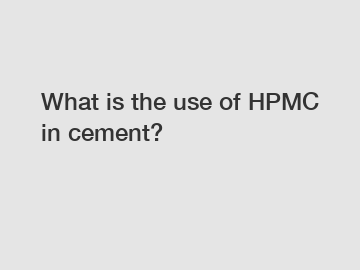What is the use of HPMC in cement?
Link to AiBeiDe
HPMC, or Hydroxypropyl Methylcellulose, is a cellulose ether that is commonly used in cement-based materials. This versatile additive plays a crucial role in enhancing the performance and workability of cement-based products. In this article, we will explore the various uses of HPMC in cement and its benefits in construction applications.
**Enhancing Workability**.

One of the primary uses of HPMC in cement is to improve the workability of the mix. HPMC acts as a water retention agent, which helps to prolong the setting time of the cement mix. This allows for better workability and easier application of the cement. The use of HPMC in cement also helps to reduce water segregation and bleeding, resulting in a more uniform and consistent mix.
**Improving Adhesion**.
Another important use of HPMC in cement is to improve the adhesion between the cement and other materials. HPMC works by forming a thin film on the surface of the cement particles, which enhances the bond strength between the cement mix and substrates such as bricks, tiles, and stones. This improved adhesion helps to prevent delamination and ensures a more durable and long-lasting bond.
**Enhancing Water Retention**.
HPMC is also used in cement to enhance water retention in the mix. By forming a protective film around the cement particles, HPMC helps to prevent water evaporation during the curing process. This ensures that the cement mix remains workable for a longer period, allowing for better hydration and strength development. Enhanced water retention also helps to reduce the risk of cracks and shrinkage in the cured cement.
**Controlling Air Entrainment**.
HPMC is often used in cement to control air entrainment in the mix. Air entrainment is essential for improving the freeze-thaw resistance of cement-based materials. HPMC acts as a stabilizer, helping to create a stable air void structure in the mix. This results in improved durability and resistance to damage caused by frost and thaw cycles. By controlling air entrainment, HPMC helps to ensure that the cement mix maintains its structural integrity over time.
**Improving Rheology**.
Rheology refers to the flow and deformation behavior of materials. HPMC is known for its ability to improve the rheological properties of cement-based materials. By modifying the viscosity and flow characteristics of the mix, HPMC helps to achieve the desired consistency and workability of the cement. This is particularly useful in applications such as self-leveling underlayments, tile adhesives, and renders, where precise control over flow and leveling properties is essential.
**Conclusion**.
In conclusion, HPMC plays a vital role in enhancing the performance and workability of cement-based materials. Its use in cement helps to improve workability, adhesion, water retention, air entrainment, and rheology, ultimately leading to more durable and high-quality construction products. Whether you are working on a small DIY project or a large-scale construction project, incorporating HPMC into your cement mix can help you achieve better results.
If you have any questions about the use of HPMC in cement or would like to learn more about our products, please feel free to contact us.
Click here to get more.
The company is the world’s best gypsum retarder manufacturer supplier. We are your one-stop shop for all needs. Our staff are highly-specialized and will help you find the product you need.



